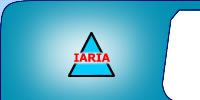

 |
The Sixth Advanced International Conference on Telecommunications AICT 2010 May 9 - 15, 2010 - Barcelona, Spain |
|
|||||||||||||
| Details: |
|
All CPS Publications are included in the IEEE Xplore All CPS Publications are archived in IEEE Computer Society Digital Library (CSDL) Authors of selected papers will be invited to submit extended versions to a IARIA Journal |
All tracks/topics are open to both research and industry contributions.
Tracks:
Signal processing, protocols and standardization
Standardization (IEEE 802.17, Policy Models, Etc.); IEEE 802.11 engineering; Telecommunications protocol engineering; Future networks: protocol and standards; Standardization (IEEE 802.15, IEEE 802.16); Communication theory, signal processing, modulation; Modulation, coding and synchronization; Propagation, antennas and channel characterization; Signal separation and Interference rejection; Critical infrastructure protection
Ad Hoc, autonomic and sensor networks
Autonomic home networking; Sensor, mesh, and Ad hoc networks; Programmable networks; Active networks; Self-organization and network reconfiguration; Partial and intermittent resources and services; Unicast and multicast routing; Radio resource sharing in wireless networks; Energy-efficient communications; Vehicular Ad hoc networks; Underwater sensor networks; Emerging sensor technologies; Intelligent video surveilance; Multi-sensor surveillance;
Wireless technologies
3G And 4G Mobile communications services; Evolution from 2G To 2.5G, 3G and beyond; Wireless multimedia and networks and systems; Cellular and Ad hoc networks; Mobile broadband technologies; Mobile software (agents); Wireless access (WPAN, WLAN, WLL); Wireless communications antennas and propagation and transmission technologies; Vertical, horizontal and diagonalhandover; Broadband wireless technology (HSDPA, HSUPA, LTE, Wimax, Wiran); Cross-layer modeling and design; Heterogeneity and diversity; Ultra-wideband communications (UWB); Wireless hacking;
Management, operation and control networks
Monitoring telecommunicaitons systems; Network management contingency challenges; Real-time traffic and QoS; Performance and QoS, traffic engineering (MPLS, Diffserv, Intserv, Etc.); Telecommunications management and control of heterogeneous networks; Mobility control and mobility engineering; Mobile video surveillance; Mobility and QoS management; Communications networks security; Information security; IPR and network security;
Core technologies and access technologies and networks
Metro/Access networks; Broadband access networks and services; Next Generation Networks and technologies; Future Internet; Inteligent & Smart networks; Grid, Cluster and Internet computing; Designing and management of optical networks; Performance of optical networks; Future technologies in optical communications; PLC (Homeplug, OPERA, UPA, CEPCA, IEEE, HD-PLC Alliance);
Future applications and services
Service-oriented architectures; E-Learning and mobile learning on telecommunications; SOHO (Small Offices/Home Offices; Emerging telecommunications software tools; Object and component technologies in telecommunication software; Platforms for Web Services-based applications and services; Web Services communications, applications, and performance; Applications in telemedicine; Security and trust in future services applications;
Cognitive radio
Cognitive radio technologies and opportunistic spectrum utilization; Spectrum sensing technologies; Dynamic spectrum access; Information theory and performance limits of dynamic spectrum access; Distributed algorithms for spectrum detection and cooperative spectrum sensing; Inter- and Intra- standards interoperability; Cross-layer algorithms based on spectrum sensing techniques; Advanced signal processing techniques for cognitive radio; Physical-layer design of software radio and cognitive radio transceivers; Interference and coexistence analysis; Radio resource allocation; Decision making; Game theory; Cognitive radio with reinforcement learning; SWR and CR management; Cognitive radio sensing in the large and feature detection; Spectrum and performance management in cognitive radio networks; Cognitive radio applications; Future Internet with cognitive technologies; Flexible and opportunistic wireless access; Multimedia communications through cognitive networks; Regulatory policies on spectrum sharing for future broadband networks; Cognitive radio standards; Cognitive radio architecture for equipments; Enabling SDR technology for cognitive radio; Hardware reconfigurability; Testbbeds
Teletraffic modeling and management
Traffic and performance measurements; Traffic characterization and modeling; Trends and patterns; Scaling phenomena; Packet and flow level models; Traffic control and QosS; Queuing theory and queuing networks; Performance evaluation; Scheduling and admission control; Reservation and priority mechanisms; Overload control; Broadcast and multicast traffic control; Analytical and numerical analysis; Network design and optimization of wired and wireless networks; Mobility and resource management; Traffic monitoring and management; Traffic engineering in multi-technology networks; Internet traffic engineering; Traffic grooming; Simulation methodology for communications networks; Simulation models and tools;
E-Learning and telecommunications
Architecture of learning technology systems; Advanced uses of multimedia and hypermedia; Integrated learning and educational environments; National and international projects on e-learning and telecommunications; Remote and wireless teaching technologies; Navigational aspects for learning; e-Learning industry and universities programs; Anytime/anywhere e-learning and wearable network devices; Tutoring e-learning applications and services; Cost models for e-learning on telecommunications; Satellite technologies for e-learning; Teaching e-learning methodologies and technologies; Adaptive e-learning and intelligent applications/tools; Agent technology; Training e-learning teachers; Practical uses of authoring tools; Application of metadata and virtual reality; Collaborative learning/groupware; Intelligent tutoring systems; Internet based systems; Application of instructional design theories; Evaluation of learning technology systems; Standards related activities;




